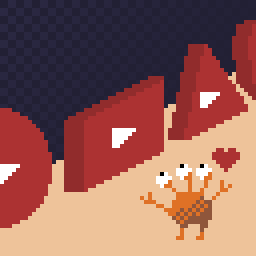I am a sucker for a bargain. If something is 90% off I’ll often buy it if I have little interest in ever playing it (that’s how I ended up with the Borderlands games, don’t tell anyone). And if you keep your eyes open, you can build quite a game library that way.
I made a list of everything on my Nintendo Switch account: <b><u><i>two hundred and seventy-one items</i></u></b></ironicfakehtmltag>. Some day I’ll give you the list, but not today. But I figured it’d be useful to people if I reported on some notable deals happening on the eShop from time to time. Nintendo doesn’t pay me to do this, and any links you use earn me nothing, it isn’t advertising. And only items that catch my eye, and survive the crushing wave of ennui these tasks produce, make it into this list.
Note 1: I round off most prices. I count every keypress dearly, and typing “.99” over and over again pours caustic soda on my remaining nerve endings.
Note 2: I use em-dashes in this. That is not proof I am some idiotic LLM, you adjective[entire] derisive noun[breadbin].
Note 3: A foundational requirement for being included in this list is it must be at least half off.
Note 4: No screenshots or covers this time. I’ve just been up all night tracking down Japanese words in the Super Famicom version of Shiren the Wanderer, my neurons are floating in a thick soup right now.
Ahem:
General
The Wonderful 101 Remastered ($18, 55% off) — One of the most beloved games for the Wii-U, and contains a superhero character called Wonder Toilet, I say approvingly.
Dokapon: Sword of Fury ($12.50, 50%) — new entry in the cult JRPG-styled board-and-party game series.
SteamWorld Heist II & Build Bundle ($18, 60% off) and SteamWorld Build & Dig Bundle ($14, 60% off)
Teenage Mutant Ninja Turtles: Mutants Unleashed ($16, 60% off)
Save Me Mr Tako: Definitive Edition ($3, 80% off): A rerelease of another Switch game that, I hear, was sabotaged by its original publisher. A challenging-yet-cartoony pixel art platformer with Game Boy graphics about an octopus hero, with a more involved story than you might expect. It’s three bucks, what have you got to lose?
Capcom
Resident Evil 4 ($10, 50% off) — The entry on the site spells “Resident Evil” all in lowercase for some stupid marketing reason. It’s widely acknowledge that this port of a Gamecube title is a high-point in the series, and contains zero percent zombies by weight. A lot of Resident Evil games seem to be on sale right now in fact, along with the Monster Hunter series, but I’ll leave those for you to seek out if you want them.
Street Fighter 6 (Switch 2 version, $20, 50% off) — After a dalliance with SoulCalibur back on the Dreamcast, and a ridiculous amount of time spent training amiibo fighters in Smash Ultimate, I’ve largely stayed away from fighting games. Still, it’s nice to see a classic series survive.
Devil May Cry, Devil May Cry 2, Devil May Cry 3 Special Edition (all individually $10, 50% off) — I never got into these, finding them a bit too preposterous, but I understand a lot of people like them, and hey, they’re here.
Phoenix Wright: Ace Attorney Trilogy ($10, 66% off) & Apollo Justice: Ace Attorney Trilogy ($25, 50% off) — Why is Apollo Justice more expensive than Nick’s games? I don’t know, but it’s a good reason to get it now before its price shoots back up.
Atari
AKKA ARRH ($6, 70% off): To think AKKA ARRH finally saw commercial release decades after the old Atari passed on producing its prototype, and this version was developed by Jeff Minter himself. But how do you pronounce it? Like a pirate? ARRRRRH.
In fact, a lot of Atari games are on discount right now, including multiple titles in its Recharged series of updated arcade remakes. A few others: Head Over Heels ($2, 80% off), Asteroids Recharged ($3, 80% off), Atari 50: The Anniversary Celebration ($18, 55% off), Atari Flashback Classics ($12, 70% off), Atari Mania ($6.24, 75% off) and Centipede Recharged ($3, 70% off), among many others.
SquareEnix
A lot of SquareEnix games are on sale at the moment. Collection of Mana ($16, 60% off) — Three games, Final Fantasy Legend (Game Boy), the beloved Secret of Mana (SNES) and the heretofore unreleased-in-English Seiken Densetsu III, now christened Trials of Mana. Sadly Trials, unlike Secret, doesn’t support three human players, not even in its original version, but it does offer a lot of replay value with multiple scenarios to complete.
A while bunch of Final Fantasy games are currently on sale, too many to link them all. VII is $6.39 (60% off); IX is $8.39 (also 60% off). On the Enix side of the building, Dragon Quest XI S: Echoes of an Elusive Age ($20, 50% off) is interesting. There’s also four Kingdom Hearts games with typically silly names, like HD 1.5 + 2.5 ReMIX ($16, 60% off), but be careful, many of them are cloud versions that won’t work without an internet connection. There’s also Octopath Traveler and its sequel (both $24, 60% off) and Romancing SaGa 2 ($7.50, 70% off), among others.

